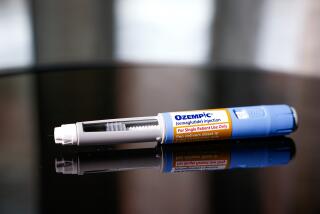They see fat where there is only skin and bone.
- Share via
While blue and red neon beer labels flashed in the bar next door, casting their muffled colors through the curtained window of the banquet room at the Best Western Motel in Valencia, a small group watched a portable television set that glowed in the darkness.
On the screen, an emaciated young woman named Lara was telling a story about eating.
Lara said she was a freshman at California Institute of the Arts in Valencia and was feeling lonely and forgotten by her family when she went on a diet that never stopped.
She lived on as little as 200 calories a day and her weight dropped from 148 to 95 pounds, Lara said.
She began to lose hair, couldn’t sleep, swung in and out of deep depressions and had difficulty concentrating. She began to crave food. Then she started going on eating binges, always forcing herself to purge the food afterward, she said.
Still, she said, she told her fiance that she felt fine and didn’t want treatment.
When the lights were turned on, a youthful-looking man in a blue suit stood at a lectern beside the television set.
He was Dr. Murray L. Zucker, 40, medical director of the 2-year-old Northridge Hospital Medical Center Eating Disorders Program.
Zucker has gone on the road to spread the news that eating disorders are epidemic and to suggest what victims and their families can do about the afflictions.
A dozen women and two men went to his talk Monday evening at the motel, situated next to Interstate 5. Some were counselors seeking professional knowledge. Others were the parents of eating-disorder victims seeking help.
Zucker said he is planning similar presentations around the area.
On Monday, he told his audience that statistics suggest that 20% of college-age women suffer from the eating disorders anorexia nervosa, the excessive self-denial of food, or bulimia, the pattern of severe overeating followed by vomiting.
To illustrate their isolation, Zucker brought along a display of self-portraits made by women in his program.
One showed a dumpy woman standing alone on a stone pathway and looking lost.
“I feel like a fat, faceless blob on a road going nowhere,” the caption said.
Another showed half of a woman’s face being bombarded by hostile lines and squiggles.
“Outside forces give me my identity,” she said in the caption. “I feel empty and afraid.”
Zucker gave a thumbnail sketch of the anorexic personality.
“Perfect child, perfect student,” he said. “Nothing bothers her. Eager to please. Then, when they become teens, a lot of pressure appears. Ultimately, they may have doubts about who they are. ‘Do I have any power? Can I control my own destiny?’ ”
Zucker said they often conclude that their diet is the only thing in their lives they can control. Meanwhile, their perceptions become distorted. They see fat where there is only skin and bone.
“The body becomes a metaphor for who we think we are,” he said.
Zucker said the negative pattern can be broken through a combination of medical treatment, nutrition counseling, group therapy, art therapy, movement therapy and sometimes drugs.
But it isn’t easy to get the victim to accept treatment, Zucker warned.
“They’ll have to give up the one thing they rely upon,” he said. “Kids and spouses will lie and cheat to avoid treatment.”
To conclude, Zucker again showed Lara in a videotape, this one made after treatment. She was attractive, zesty and honest about her problem. She said she wanted other people to know how much she had fought the treatment before but how much it had helped her.
When Zucker asked if there were any questions, a woman related a story of a young girl who admitted being bulimic but didn’t want to change.
“Should they drag her in?” she asked.
Instead of answering directly, Zucker related an experience at another meeting when the same question was asked and a recovering bulimic spoke up to answer it, saying: “Drag her in. She’s in the middle of a tornado.”
Another woman asked, “If your child is under 18, can you put them in whether they want it or not?”
“Yes you can,” Zucker said. “It’s kind of similar to a child with a drug problem.”
Zucker answered questions about the length of the treatment and insurance benefits.
Then a third woman asked him to compare his program to that offered at Glendale Adventist Medical Center.
He said the question reminded him of a woman who once told him on the phone that she was shopping around.
He said she complained, “I’ve got a very sick daughter and I feel like I’m looking for a used car.”
Someone pointed out that the answer wasn’t very responsive to the question.
Fidgeting a bit, Zucker took another shot at it.
He said the Glendale Adventist program follows the Overeaters Anonymous treatment program, based on the Alcoholics Anonymous method, which, he said, demands “submission to a greater spirit.”
“The question is, is eating disorder the same as alcoholism?” Zucker asked.
He obviously didn’t think so.
Eating disorders often begin with someone’s overreliance on another greater spirit, he said. His preference in treatment is to get them in tune with their own spirit, not someone else’s.
And so, 14 people left the room armed with the knowledge that they can shop around, as well as drag their loved ones in.
More to Read
Sign up for Essential California
The most important California stories and recommendations in your inbox every morning.
You may occasionally receive promotional content from the Los Angeles Times.











